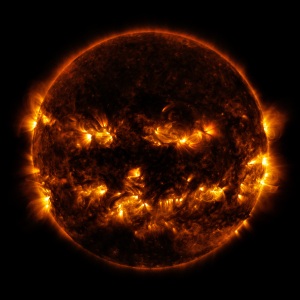An object is said to be “blackbody” if it emits the radiation into space that originates completely from its temperature. It means radiation comes from light waves mixing it up with jiggling motions of all the zillions of atoms that jointly make up the object. Blackbody spectra doesn’t depend on an object’s chemical composition, its size or its age.
 Black-body radiation is the type of electromagnetic radiation within or surrounding a body in thermodynamic equilibrium with its environment, or emitted by a black body at constant, uniform temperature. The radiation is emitted according to Planck’s law.
Black-body radiation is the type of electromagnetic radiation within or surrounding a body in thermodynamic equilibrium with its environment, or emitted by a black body at constant, uniform temperature. The radiation is emitted according to Planck’s law.
The object is called as black body as per its properties:
1. It is an ideal emitter; at every frequency, it emits more energy than any other body at the same temperature.
2. It is also a diffuse emitter because the energy is radiated isotropically, independent of direction.
There is no relation with the color of body or object. Blackbodies do not have to be black. They can be of any other colour like red, blue, yellow or white. Scientists gave the name blackbody to such objects because anything colored black absorbs all the wavelength(colors) of light that on to it. Similar in the case of such objects. Such type objects can absorb all kind of wavelengths and emits radiation with respect to the temperature. Anything which has heat and is dense enough will emit as a blackbody. It means, even the chair you’re sitting on and the Earth on which the chair rests are all blackbodies. But also no perfect black body exists.
The total light emitted by blackbody always varies with its frequency. The blackbody curve is the particular way to specify the number of red photons, the number of green photons, the number of infrared and ultraviolet photons. The exact form of the curve depends only on the object’s temperature. Every blackbody at 2000 degrees emits light with exactly the same curve. Since the peak of the blackbody curve is where most of the radiation is emitted, you can see how changing the star’s temperature changes its color.
Stars are vast collections of hot gas. A star like the Sun is more than ten billion billion billion tons of matter crammed together under the force of its own gravity. The conditions in a star (dense and hot) make it a pretty nice example of a blackbody.
According to Stephen Hawking’s new research, “there are no black holes”. Read here-
http://www.extremetech.com/extreme/175414-stephen-hawking-research-there-are-no-black-holes
Why are stars White?
Rather than spectrum of light produced by stars, it has more to do with physiology of the eye.
Stars emit light over the full range of visible wavelengths. Hot stars emit more blue/violet light, cool stars emit more red light. The Sun is relatively neutral in that regard, so does not have a strong coloration, but many other stars in the sky have temperatures as low as 3,000K (should appear reddish) to 20,000K or more (should be blueish).
However, light received by the eye has to be reasonably bright to trigger the color sensitive cells (the cones). So whereas the Sun appears to be yellow(ish) (or to be more exact your eyes perceive the mix of wavelengths as yellowish), there are relatively few stars that are bright enough to look distinctly colored. Betelgeuse is an example that most people see as reddish. Arcturus is distinctly orange (to me).
But fainter stars all appear white because they are mainly being seen by the rod cells in your eye, which are not very color sensitive (and have no sensitivity to light at the extremes of red and blue). This is known as scotopic vision.
Source:
http://physics.stackexchange.com/questions/169969/why-are-stars-white